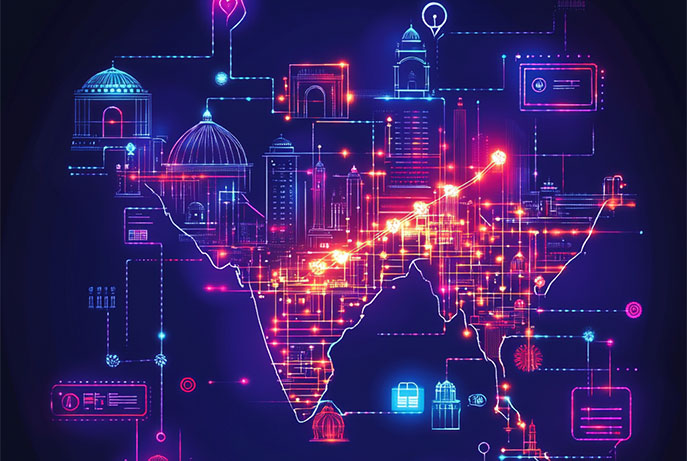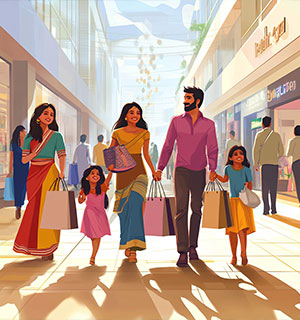Why India is the Final Frontier for Global Brands
India is poised to become a defining force in the global economy, presenting an unprecedented opportunity for international brands. With its fast-growing economy, burgeoning consumer base, and increasing appetite for premium and luxury products, India stands as the "final frontier" for global brands aiming to secure sustainable growth in a competitive world.

India’s Economic Growth: A Powerhouse in the Making
India's economy is projected to grow at a remarkable pace, with the International Monetary Fund (IMF) estimating a GDP growth rate of 6.1% for 2024, making it one of the fastest-growing major economies. By 2035, India’s economy is expected to surpass $10 trillion, driven by strong domestic consumption, a youthful workforce, and technological innovation. Apple has been ramping up production in India, with its largest manufacturing facility set up in Tamil Nadu. This move is part of a broader strategy to reduce dependency on China and leverage India's improving manufacturing ecosystem. For global brands, this economic trajectory signals vast opportunities to tap into a market that is both resilient and expansive. India's economic growth not only reflects its increasing consumer spending power but also underlines its importance as a stable and lucrative investment destination.
Rising Consumer Base: The Demographic Dividend

India’s population of over 1.4 billion includes the world’s largest working-age population, with a median age of 28. More than 140 million households are expected to join the middle class by 2030, adding significant disposable income to the economy. Moreover, the World Economic Forum estimates that India’s middle class will drive 70% of consumption growth over the next decade. Zara has successfully adapted its operations to target Indian consumers by offering regionally favored designs and maintaining premium positioning. Despite higher price points, it continues to expand its footprint due to sustained demand from urban millennials. The rise of India’s digital economy has also brought global e-commerce giants like Amazon and Walmart-owned Flipkart into the spotlight. With over 900 million internet users expected by 2025, digital penetration has amplified consumer access to premium products, creating a fertile ground for brands to grow. The demographic dividend combined with rising incomes creates a consumer base that is not just growing but increasingly sophisticated. Global brands have the opportunity to cater to this aspirational segment, particularly in urban and semi-urban areas.
The Growth of India’s Premium and Luxury Market
India's premium market, particularly in sectors like fashion, beauty, and automobiles, is growing rapidly. Premium products are increasingly sought after by the burgeoning middle class and affluent urban consumers, who view them as status symbols and reflections of personal success. India's luxury market is on a growth trajectory, estimated to reach $8.5 billion by 2025, according to Bain & Company. This growth is fueled by affluent millennials, tech-savvy Gen Z consumers, and a growing appetite for high-quality, status-driven products. Tier 2 and Tier 3 cities, which contribute over 50% of new retail consumption growth, are becoming significant contributors to this trend. Louis Vuitton reported a double-digit growth rate in India in 2023, driven by rising demand from young professionals and affluent consumers in Tier 2 cities like Chandigarh and Jaipur. Similarly, luxury car brands such as Mercedes-Benz and BMW have seen record-breaking sales, with a significant portion of demand coming from smaller cities. The premium market in India highlights the demand for not only traditional luxury items but also niche categories like premium skincare, high-end home appliances, and gourmet foods. Global brands that position themselves within this evolving landscape can capture significant market share. The luxury market’s expansion highlights the evolving preferences of Indian consumers. For global brands, the opportunity lies not just in metros but in unlocking the untapped potential of smaller cities where aspirational spending is on the rise.

The Time to Enter is Now
India’s economic ascent, dynamic consumer base, and growing premium market make it a pivotal destination for global brands. However, timing is critical. Brands that establish a foothold in India today will be better positioned to dominate tomorrow’s consumer landscape.
Key takeaways
Capitalize on growth: India’s economic momentum presents a once-in-a-generation opportunity for sustained growth.
Target rising affluence: Focus on middle-class and luxury segments, particularly in Tier 2 and Tier 3 cities.
Localize effectively: Adapt offerings to resonate with diverse regional preferences and cultural norms.
Leverage technology: Digital transformation and e-commerce are critical channels for reaching India’s tech-savvy consumers.
Act now: Early movers will gain a competitive advantage, benefiting from first-mover loyalty and market share.
For CXOs, India is a strategic imperative. The brands that seize this opportunity with foresight and agility will lead the next wave of global success.
Blogs
Stay up-to-date with the latest insights on India’s market trends and opportunities. Our blog offers expert analysis and practical advice for brands looking to thrive in one of the world’s most exciting markets


